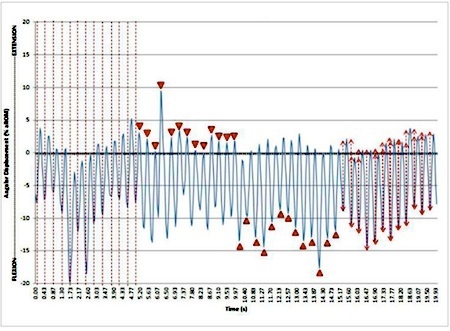Marc Abrahams's Blog, page 378
September 13, 2014
Doorknobs (not just elevator buttons) going viral. Oh, my!
Almost immediately after the fearful news about elevator buttons, and with the world worried about the Ebola virus, the American Society for Microbiology has issued a press release decrying the dangers of doorknobs.
As I wrote here recently, three doctors in Toronto wrote a little study about the bacteria they found on hospital elevator buttons. That study might foster a renewed yearning for so-called bacteria-killing soaps, lotions, and other products that claim to wipe out scary bugs. There’s an entire industry devoted to those products — products that can, if used carelessly, end up doing more harm than good….
So begins another Improbable Innovation nugget, which appears in its entirety on BetaBoston.

The bad news sandwich
To set the scene, an Improbable joke.
Doctor : “Ah, Mr. Smith, we have some good news and some bad news, which do you want first?”
Mr. Smith : “Gimme the bad news doc.”
Doctor : “We amputated the wrong foot.”
Mr. Smith : “Agggggh ! – And the good news?”
Doctor: “The other one’s getting better.”
 Joking aside, a research project, published in Pers Soc Psychol Bull October 31, 2013, examines news-order preferences: ‘Do You Want the Good News or the Bad News First? The Nature and Consequences of News Order Preferences’
Joking aside, a research project, published in Pers Soc Psychol Bull October 31, 2013, examines news-order preferences: ‘Do You Want the Good News or the Bad News First? The Nature and Consequences of News Order Preferences’
Ph.D Candidate Angela M. Legg and professor Kate Sweeny, of the Life Events Lab at University of  California, Riverside, US, have been examining what they call ‘Uncertainty Navigation’. And, in three separate experimental studies it was found that news-recipients (of both good and bad news) sometimes have different preferences for the order in which the news is delivered, for example :
California, Riverside, US, have been examining what they call ‘Uncertainty Navigation’. And, in three separate experimental studies it was found that news-recipients (of both good and bad news) sometimes have different preferences for the order in which the news is delivered, for example :
“Under some circumstances, people may welcome bad news, particularly when the news can guide decision-making or motivate behavior (Trope, 1986). […] Although bad news may be less holistically ‘bad’ when it is useful, we suspect that our findings regarding news order preferences generalize across news that varies in usefulness.”
The paper also highlights strategies that news-givers might bear in mind :
“[...] news-givers might attempt to further soften the blow of bad news by delivering bad news encased within a ‘bad news sandwich’ or good-bad-good pattern.”

September 12, 2014
“Glee in small children” Ig Nobel winner profiled in Spain
The 2001 Ig Nobel Prize for psychology was awarded to Lawrence W. Sherman of Miami University, Ohio, for his study called “An Ecological Study of Glee in Small Groups of Preschool Children.”
Now Radio Onda Cero, in Spain, discusses the importance of Sherman’s glee study.

Ig Nobel bellybutton-lint pioneer previews this year’s ceremony
A past Ig Nobel Prize winner gives his personal preview of next week’s Ig Nobel Prize ceremony, in an interview with NineMSN:
Look down at your bellybutton – discreetly, if you’re at work. Is there fluff or lint inside it? Yes? There’s a very strong chance that it’s blue.
The reasons for this only became clear when Australian scientist, author and broadcaster Dr Karl Kruszelnicki conducted research into it in 2007.
“Bellybutton fluff was made of the fibres of clothing held together with dead skin cells. The average colour of clothing that we wear in western society is blue. If you go to the trouble of wearing red clothing with red underwear, you’ll have red belly button fluff,” Dr Karl told ninemsn.
These findings won Dr Karl an Ig Nobel prize, and next week the winners of the 2014 Ig Nobels will be announced.
The quirky cousin of the Nobel prizes, the awards are given to research that “makes you laugh, then makes you think”, and the ceremonies are light-hearted affairs.
“They flew me to Harvard to accept the award at my own expense, because they wouldn’t want to insult me with money,” Dr Karl said….

Medical effects of coffee: Two new insights
Does it matter, medically, whether you drink coffee or not? Here are two further insights into this life-or-death question:
“Coffee consumption and hip fracture risk: a meta-analysis,” X.L. Li and J.H. Xu, Journal of Nutritional Science, 2013 Jul 24;2:e23. The authors, at the Medical College of Soochow University, China, report:
“Although our meta-analysis has provided insufficient evidence that coffee consumption significantly increases hip fracture risk, coffee intake may increase hip fracture risk…”
“Coffee consumption and risk of prostate cancer: a meta-analysis of epidemiological studies,” Chang-Hae Park, et al., BJU International, Volume 106, Issue 6, pages 762–769, September 2010. The authors, at National Cancer Center, Goyang, South Korea, and other institutions, report:
“there is no evidence to support a harmful effect of coffee consumption on prostate cancer risk. Further prospective cohort studies are required.”

September 11, 2014
The physics of — and a recipe for making — Murphy’s toast
 Ig Nobel Prize winner Robert Matthews devised a recipe for making a culinary delight: Murphy’s Toast. The recipe is included in the new book The Ig Nobel Cookbook, volume 1.
Ig Nobel Prize winner Robert Matthews devised a recipe for making a culinary delight: Murphy’s Toast. The recipe is included in the new book The Ig Nobel Cookbook, volume 1.
In this video, Matthews demonstrates his prize-winning achievement: explaining why buttered toast so often falls on the buttered side.

The Index of The Indexer
Dip, if you dare, into the Cumulative Index from 1996 (vol 20) onwards of The Indexer. The Indexer is, by its own admission, “the international journal of indexing”.
(Disclaimer/proclaimer: I am an entry in that cumulative index, because of “The“, which led to this.)

September 10, 2014
Food-chewing-noise patent application
“
Successful dieting requires long-term behavior modification in terms of eating and physical activity. A diet plan is only one part of the solution. Sticking to the plan requires behavior modification that is generally beyond the ability of most people to implement without external assistance.”
An invention, designed to provide assistance on such occasions is proposed in a 2011 US patent application by inventors Tadmor (Teddy) Shalon and Leonardo Gabriel Neumeyer of Palo Alto, California. Their ear-mounted device, called the iWhisper, [pictured above] not only senses jaw-motion but also measures, records and identifies specific ‘acoustic fingerprints’ of various foods (via the sounds they make when chewed). Advice, for or against continuing eating, is then provided to the user via the earpiece.
Notes:
• Details regarding iWhisper, should it become commercially available, may be found here.
• iWhisper should not be confused with iWhisper (a tourism app.)
Also see: The Ig Nobel 2008 Nutrition Prize which was awarded to Massimiliano Zampini of the University of Trento, Italy and Charles Spence of Oxford University, UK, for electronically modifying the sound of a potato chip to make the person chewing the chip believe it to be crisper and fresher than it really is.

September 9, 2014
Kinematics of coitus in five pre-selected positions
Natalie Sidorkewicz carefully analyzed spine and hip motions of ten couples each having sex in five positions. Sidorkewicz wrote it up, as her master’s thesis :
“Lumbar Spine and Hip Kinematics and Muscle Activation Patterns during Coitus: A comparison of common coital positions,” Natalie Sidorkewicz, Master of Science thesis in Kinesiology, University of Waterloo, 2013.
The main objective of this study was to describe male and female lumbar spine and hip motion and muscle activation patterns during coitus and compare these motions and muscle activity across five common coital positions. Specifically, lumbar spine and hip motion in the sagittal plane and electromyography signal amplitudes of selected trunk, hip, and thigh muscles were described and compared…..
Ten healthy males (29.3 ± 6.9 years, 176.5 ± 8.6 centimeters, 84.9 ± 14.5 kilograms) and ten healthy females (29.8 ± 8.0 years, 164.9 ± 3.0 centimeters, 64.2 ± 7.2 kilograms) were included for analysis in this study. These couples had approximately 4.7 ± 3.9 years of sexual experience with each other. This study was a repeated-measures design, where the independent variables, coital position and condition, were varied five times, respectively. Recruited participants engaged in coitus in five pre-selected positions (presented in random order) for 20 seconds per position first in a simulated condition, and again in a real condition….
To determine if each coital position had distinct spine and hip kinematic and muscle activation profiles, separate univariate general linear models) followed by Tukey’s honestly significant difference (HSD) post hoc analysis were used.
Here’s detail, concerning the missionary position, from the study:

Sidorkewicz also wrote it up in a form that’s about to be published in a journal:
“Male Spine Motion during Coitus: Implications for the low back pain patient,” Natalie Sidorkewicz, Spine, vol. 39, no. 20, September 15, 2014.
BONUS: Pek van Andel’s Ig Nobel Prize-winning, pioneering MRI images of a couple’s sex organs in use, in a single sexual position (prone, stuffed into an MRI machine:)

The Digit Ratio and the Feminist Paradox
If you know what the digit ratio is [it's the length of your second finger compared to the length of your fourth finger], the title of this study maybe tells you everything you need to know to appreciate the value of the study:
“Feminist activist women are masculinized in terms of digit-ratio and social dominance: a possible explanation for the feminist paradox.” , [pictured here], John Wallert and Michael A. Woodley, Frontiers in Psychology, epub September 9, 2014. (Thanks to investigator Parker Brown for bringing this to our attention.) The authors are at Umeå University, Sweden, and Vrije Universiteit Brussel, Belgium.
BONUS: Professor John Manning of the University of Liverpool is the big gun, the very index finger, among finger-length-comparison scholars. We have written about many of his exploits. He appears again and again in the new book This Is Improbable Too.

Marc Abrahams's Blog
- Marc Abrahams's profile
- 14 followers



